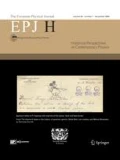Abstract
This paper describes the life and work of a figure who, we argue, was of primary importance during the early years of field quantisation and (albeit more indirectly) quantum gravity. A student of Dirac and Born, he was interned in Canada during the second world war as an enemy alien and after his release never seemed to regain a good foothold in physics, identifying thereafter as a mathematician. He developed a general method of quantizing (linear and non-linear) field theories based on the parameters labelling an arbitrary hypersurface. This method (the ‘parameter formalism’ often attributed to Dirac), though later discarded, was employed (and viewed at the time as an extremely important tool) by the leading figures associated with canonical quantum gravity: Dirac, Pirani and Schild, Bergmann, DeWitt, and others. We argue that he deserves wider recognition for this and other innovations.
Similar content being viewed by others
References
R. Arnowitt, S. Deser, C. Misner, The Dynamics of General Relativity. In Gravitation, edited by L. Witten (Wiley, 1962), pp. 227-265.
P.G. Bergmann, J.H.M. Brunnings, Non-Linear Field Theories II. Canonical Equations and Quantization. Reviews of Modern Physics 21: 480-487 (1949).
P.G. Bergmann, Quantization of the Gravitational Field, 1930–1988. In Studies in the History of General Relativity, edited by J. Eisenstaedt and A.J. Kox (Birkhaüser, 1992), pp. 364-366.
G. Bhamathi, E.C.G. Sudarshan, Time as a dynamical variable. Physics Letters A 317: 359-364 (2003).
H. Bondi, Science, Churchill and Me (Pergamon, 1990).
M. Born, My Life: Recollections of a Nobel Laureate (Charles Scribner’s Sons, 1975).
Cultural Heritage and Prisoners of War: Creativity Behind Barbed Wire, edited by G. Carr, H. Mytum (Routledge, 2012).
E. Cartan, Leçons sur les invariants intégraux (Librairie Scientifique A. Hermann, 1922).
Refugee Scholars: Conversations with Tess Simpson, edited by R.M. Cooper (Moorland Publishing, 1992).
Th. De Donder, Théorie invariantive du calcul des variations (Gauthier-Villars, 1935).
J.S. de Wet, On the Relativistic Invariance of Quantized Field Theories. Proceedings of the Royal Society of London A 195: 365-376 (1948).
P.A.M. Dirac, The Lagrangian in Quantum Mechanics. Physikalische Zeitschrift der Sowjetunion 3: 64-72 (1933).
P.A.M. Dirac, Generalized Hamiltonian Dynamics. Canadian Journal of Mathematics 2: 129-148 (1950).
P.A.M. Dirac, The Hamiltonian Form of Field Dynamics. Canadian Journal of Mathematics 3: 1-23 (1951).
Totally Un-English? Britain’s Internment of Enemy Aliens in Two World Wars, edited by R. Dove (Editions Rodopi B.V, 2005).
K. Fuchs, On the Invariance of Quantized Field Equations. Proc. Roy. Soc. Edin. A 59: 109-121 (1939).
J. Goldberg, Syracuse: 1949–1952. In The Universe Of General Relativity. Einstein Studies, edited by A.J. Kox and J. Eisenstaedt (Birkhaüser, 2005), Vol. 5, pp. 359-373.
A. Gsponer, J.-P. Hurni, Lanczos’s functional theory of electrodynamics: A commentary on Lanczos’s Ph.D. dissertation. Cornelius Lanczos. Collected Published Papers With Commentaries, edited by W.R. Davis et al. (North Carolina State University, Raleigh, 1998), Vol. 1, pp. 2-23.
A. Gsponer, J.-P. Hurni, Cornelius Lanczos’s derivation of the usual action integral of classical electrodynamics. Foundations of Physics 35: 865-880 (2005).
W. Heisenberg, P. Wolfgang, Zur Quantendynamik der Wellenfelder. Zeitschrift für Physik 56: 1-61 (1929).
W. Heisenberg, P. Wolfgang, Zur Quantentheorie der Wellenfelder. II. Zeitschrift für Physik 59: 168-190 (1929).
G. Juvet, Sur une équation aux dérivées fonctionelles partielles et sur une généralisation du théorème de Jacobi. Ph.D. thesis, Université de Paris, 1926.
J. Jauch, F. Rohrlich, The Theory of Photons and Electrons (Palgrave Macmillan, 1955).
E.W. Kellerman, A Physicist’s Labour in War and Peace: Memoirs 1933–1999 (M-Y Books, 2007).
R. Kohn, Nazi Persecution: Britain’s Rescue of Academic Refugees. European Review 19: 255-283 (2011).
C. Laucht, Elemental Germans: Klaus Fuchs, Rudolf Peierls and the Making of British Nuclear Culture 1939–1959 (Addison-Wesley, 2012).
K.A. Milton, Julian Schwinger: From Nuclear Physics and Quantum Electrodynamics to Source Theory and Beyond. Physics in Perspective 9: 70-114 (2007).
R. Nossum, Emigration of mathematicians from outside German-speaking academia 1933–1963, supported by the Society for the Protection of Science and Learning. Historia Mathematica 39: 84-104 (2012).
F.A.E. Pirani, On the Quantization of the Gravitational Field of General Relativity. Ph.D. Thesis, Carnegie Institute of Technology, 1952.
G. Prange, Die Hamilton-Jacobische Theorie für Doppelintegrale. Ph.D. Thesis, Georg-August Universität Göttingen, 1915.
M.H.L. Pryce, On the New Field Theory. II. Quantum Theory of Field and Charges. Proceedings of the Royal Society of London A 159: 355-382 (1937).
L. Rosenfeld, Bemerkung Über die Invarianz der kanonischen Vertauschungsrelationen. Zeitschrift für Physik 63: 574-575 (1930).
E. Rutherford, A Society for the Protection of Science and Learning. British Medical Journal 1: 607 (1936).
S.S. Schweber, QED and the Men Who Made It (Princeton University Press, 1994).
J. Stachel, The Cauchy Problem in General Relativity – The Early Years. In Studies in the History of General Relativity, edited by J. Eisenstaedt and A.J. Kox (Birkhaüser, 1992), pp. 407-418.
J. Stachel, The Hole Argument and Some Physical and Philosophical Implications. Living Rev. Relativity 17: (2014), available at: http://www.livingreviews.org/lrr-2014-1.
P. Weiss, On the Hamilton-Jacobi Theory and Quantization of a Dynamical Continuum. Proceedings of the Royal Society of London A 169: 102-119 (1938).
P. Weiss, On the Hamilton-Jacobi Theory and Quantization of Generalized Electrodynamics. Proceedings of the Royal Society of London A 169: 119-133 (1938).
P. Weiss, On the Quantization of a Theory Arising from a Variational Principle for Multiple Integrals with Application to Born’s Electrodynamics. Proceedings of the Royal Society of London A 156: 192-220 (1936).
P. Weiss, On some applications of quaternions to restricted relativity and classical radiation theory. Proc. Roy. Irish. Acad. 46: 129-168 (1941).
P. Weiss, Review of Tonnelat, Marie-Antoinette “La particule de spin 2 et la loi de gravitation d’Einstein dans le cas de présence de matière”, C. R. Acad. Sci. Paris 218: 305-308 (1944). Mathematical Reviews: MR0013051.
D. Zimmerman, The Society for the Protection of Science and Learning and the Politicization of British Science in the 1930s. Minerva 44: 25-45 (2006).
Author information
Authors and Affiliations
Corresponding author
Rights and permissions
About this article
Cite this article
Rickles, D., Blum, A. Paul Weiss and the genesis of canonical quantization. EPJ H 40, 469–487 (2015). https://doi.org/10.1140/epjh/e2015-60001-5
Received:
Revised:
Published:
Issue Date:
DOI: https://doi.org/10.1140/epjh/e2015-60001-5




